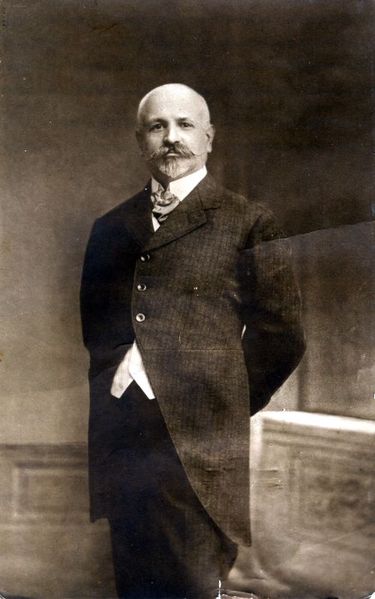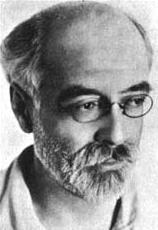<Back to Index>
- Anarchist Francesc Ferrer i Guàrdia, 1859
- Anarchist Revolutionary Vsevolod Mikhailovich Eikhenbaum (Voline), 1882
PAGE SPONSOR

Francesc Ferrer i Guàrdia (10 January 1859 – 13 October 1909) (known as Francisco Ferrer y Guardia in Spanish and often simply as Francisco Ferrer) was a Spanish Catalan free thinker and anarchist.
He was born in Alella (a small town near Barcelona) to Roman Catholic parents. A follower of Spanish republican leader Manuel Ruiz Zorrilla, Ferrer was exiled to Paris with his wife and children in 1885. Divorcing in 1899, he remarried a wealthy Parisian teacher shortly thereafter.
In 1901 he returned to Spain and opened the Escuela Moderna (The Modern School) to teach middle class children (then) radical social values. In 1906 he was arrested on suspicion of involvement with Mateu Morral's attack on King Alphonso XIII and released uncharged over a year later. His school failed and closed while he was incarcerated.
Early in the summer of 1908, after his release from jail, he wrote the story of the Modern School. The work was entitled The Origins and Ideals of the Modern School and was translated into English by Joseph McCabe and published by the Knickerbocker Press in 1913.
Following the declaration of martial law in 1909 during the Tragic Week, he was arrested and executed without trial by firing squad at Montjuich Fortress in Barcelona on 13 October.
Shortly after his execution, numerous supporters of Ferrer's ideas in the United States formed what were called Modern Schools, or Ferrer Schools, modeled after la Escuela Moderna. The first and most notable Modern School was formed in New York City in 1911, and then later a community was founded around a school, known as Ferrer Colony and Modern School.
In Anarchism and Other Essays, Emma Goldman
called Francesc Ferrer a "rebel" and said that "his spirit would rise
in just indignation against the iron régime of his country..."

Vsevolod Mikhailovich Eikhenbaum (Russian: Все́волод Миха́йлович Эйхенба́ум; August 11, 1882 - September 18, 1945), known in later life as Volin or (the spelling he used himself) Voline (Во́лин), was a leading Russian anarchist who participated in the Russian and Ukrainian Revolutions before being forced into exile by the Bolshevik Party government. He was a main proponent of the anarchist organizational form known as synthesis anarchism.
He was born in the Voronezh district of Central Russia, where both his parents were doctors, and after finishing college there he went to Saint Petersburg to study jurisprudence. In 1904 he left the university, joined the Socialist - Revolutionary Party and became involved in the revolutionary labor movement. He was engaged in cultural and educational activity among the workers of the city when he met Father Gapon and joined his petition movement; on Bloody Sunday (1905) he was with a group that was turned back by soldiers before it could reach the Winter Palace. During the ensuing strikes he took the lead in creating the first St. Petersburg Soviet in order to coordinate aid and information for the workers; although quiescent much of the year and finally suppressed in December after the Russian Revolution of 1905, the Soviet was revived during the February Revolution of 1917.
After his escape from arrest in 1907 he fled to France, where he came under the influence of Russian anarchists and joined that movement, a small group of Apollon Karelin, in 1911.
He took part in the Russian Civil War, at first in the Ukrainian anarchist organization Nabat, then (from August 1919) in the army of Nestor Makhno. Arrested by the Bolsheviks in January 1920, he was released from prison along with other anarchists in October because of a treaty between the Soviet Union and Makhno's army. Rearrested a month later, he joined the Taganka Prison hunger strike. Thanks to the intervention of the Red Trade Union International, during its Congress (Съезд Красного Профинтерна) held in Moscow in the summer of 1921, he was finally expelled from the country.
Admitted to Germany despite lack of proper documents, he and his family lived in Berlin, where he wrote (in German) an 80 page pamphlet called The Persecution of the Anarchists in Soviet Russia, translated Peter Arshinov's История махновского движения (History of the Makhnovist Movement) and wrote a long biographical preface for it, and edited a Russian anarchist magazine. After two years he received an invitation from Sébastien Faure to help him prepare the Encyclopédie Anarchiste, so he moved to Paris, where he wrote for the Encyclopédie and other publications.
The death of his wife affected him severely, and World War II
forced him to move from one hiding place to another; he returned to
Paris after the war, but developed incurable tuberculosis and died in a
hospital in September 1945, leaving his account of his experiences in
the revolutions and civil war, La Révolution inconnue (The Unknown Revolution), to be published posthumously.
Volin was a prolific writer and anarchist intellectual who played an important part in the organization and leadership of Nabat. The Nabat Confederation of Anarchist Organizations, better known simply as Nabat (Набат), was an anarchist organization that came to prominence in Ukraine during the years 1918 to 1920. The area where it held the most influence is sometimes referred to as the Free Territory, though Nabat had branches in all of the major cities in southern Ukraine.
Volin was charged with writing a platform for Nabat that could be agreeable to all the major branches of anarchism, most importantly Anarcho - syndicalism, Anarcho - collectivism / communism, and Anarcho - individualism. The uniform platform for Nabat was never truly decided upon, but Volin used what he had written and the inspiration from Nabat to create his Anarchist Synthesis. The proposed platform for Nabat included the following sentence which anticipated synthesis anarchism: "These three elements (syndicalism, communism and individualism) are three aspects of a single process, the building, of the organization of the working class (syndicalism), of the anarcho - communist society which is nothing more than the material base necessary for the complete fullness of the free individual."
Two texts made as responses to the Platform, each proposing a different organizational model, became the basis for what is known as the organization of synthesis, or simply "synthesism". Voline published in 1924 a paper calling for "the anarchist synthesis" and was also the author of the article in Sebastian Faure's Encyclopedie Anarchiste on the same topic. The main purpose behind the synthesis was that the anarchist movement in most countries was divided into three main tendencies: communist anarchism, anarcho - syndicalism, and individualist anarchism and so such an organization could contain anarchists of these 3 tendencies very well.